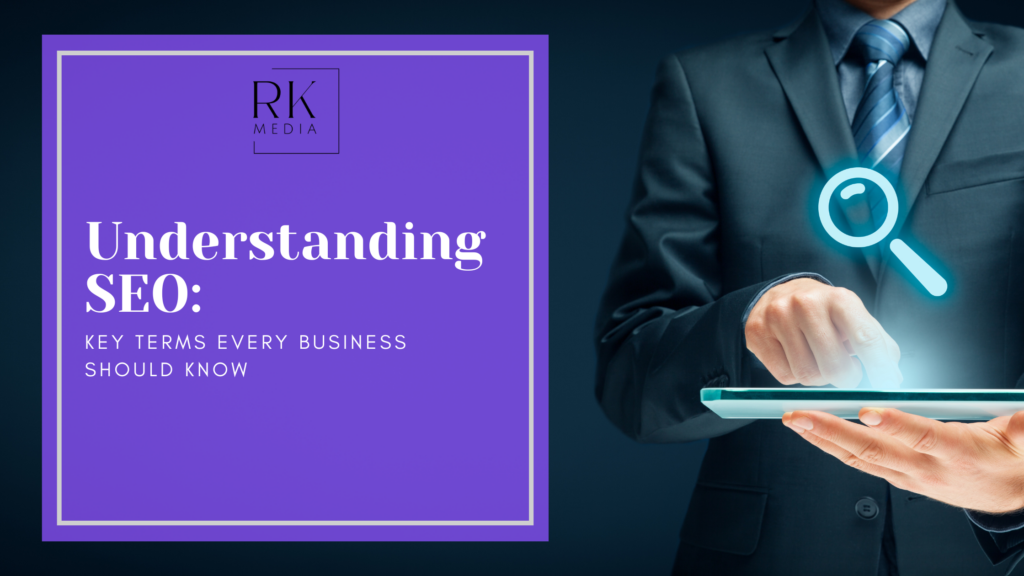Understanding SEO:
Key Terms Every Business Should Know

Search Engine Optimisation (SEO) is an essential aspect of digital marketing. It involves a range of strategies aimed at improving a website’s visibility on search engine results pages (SERPs). By optimising a site for SEO, businesses can attract more organic traffic, increase their online presence, and ultimately, grow their customer base. However, SEO can sometimes feel overwhelming, especially with all the technical jargon. In this blog, we’ll break down some of the most important SEO terms and explain them in simple terms to help you better understand how they can impact your business.
1. Keywords
Keywords are the words and phrases that people type into search engines when looking for information, products, or services. For instance, if someone is looking for a digital marketing agency, they might search for “digital marketing services” or “SEO agency near me”. By incorporating these keywords into your website content, you increase the chances of appearing in search results when users search for these terms.
Example: If your business sells handmade candles, using keywords like “handmade soy candles” or “natural scented candles” in your product descriptions can help attract more visitors looking for these items.
2. Organic Traffic
Organic traffic refers to the visitors that come to your website naturally through search engines, without any paid advertising. This traffic is crucial because it often consists of users actively searching for information, products, or services you offer. The better your SEO, the more organic traffic you’ll receive, making it a vital component of any digital marketing strategy.
Why It Matters: Organic traffic is generally more valuable than paid traffic, as these users are specifically interested in your offerings, increasing the likelihood of conversions.
3. On-Page SEO
On-page SEO involves optimising various elements on your web pages to improve your site’s visibility in search engines. This includes optimising your content, using appropriate keywords, improving meta tags (such as title tags and meta descriptions), and ensuring your images have descriptive alt text.
Example: If you write a blog post, using the right keywords in your headings, body text, and images helps search engines understand what the post is about, increasing its chances of ranking higher in search results.
4. Off-Page SEO
Off-page SEO refers to the actions taken outside of your own website to improve its ranking. The most common method is backlinking, where other websites link back to your site. When reputable sites link to your content, search engines see this as a sign of trust and authority, which can boost your ranking.
Tip: Building quality backlinks from relevant and authoritative websites, such as industry blogs or news outlets, can significantly enhance your site’s SEO.
5. Meta Tags
Meta tags are snippets of text that describe a page’s content; they don’t appear on the page itself but are part of the page’s code. Two important types are the meta title and meta description:
- Meta Title: The title that appears on search engine results and browser tabs.
- Meta Description: A short summary that appears under the title in search results, providing an overview of the page’s content.
Why They’re Important: Well-optimised meta tags can increase the click-through rate (CTR) as they give users and search engines a clear idea of what your page is about.
6. Alt Text (Alternative Text)
Alt text is a brief description added to images on your website. It helps search engines understand what an image is about, which is crucial for SEO, as search engines cannot ‘see’ images the way humans do. Additionally, alt text improves accessibility for users with visual impairments.
Example: If you have a picture of a handmade candle, an effective alt text might be “handmade lavender-scented soy candle in a glass jar”.
7. Backlinks
Backlinks (also known as inbound or incoming links) are links from other websites that point to your site. They are important because search engines view them as endorsements of your content’s quality and relevance. The more high-quality backlinks you have, the more likely search engines are to trust and rank your site higher.
Best Practice: Aim to build links from reputable and relevant websites in your industry. Guest blogging, PR outreach, and creating shareable content are effective ways to gain valuable backlinks.
8. SERP (Search Engine Results Page)
The SERP is the page you see after entering a search query into a search engine like Google. It lists the results that the search engine believes are the most relevant to your query. Your goal in SEO is to have your web pages appear as high as possible on the SERP, ideally on the first page, as most users rarely click beyond that.
Did You Know?: The top result on a SERP gets approximately 28% of the clicks, so aiming for the first position can significantly boost your website traffic.
9. Domain Authority (DA)
Domain Authority is a score (ranging from 1 to 100) developed by companies like Moz, which predicts how well a website will rank on search engine results pages. Websites with a higher DA score are more likely to rank higher. Factors influencing DA include the quality of backlinks, the site’s overall SEO structure, and its trustworthiness.
Quick Tip: To increase your site’s DA, focus on building quality backlinks, optimising your on-page SEO, and ensuring your website is secure and mobile-friendly.
10. Bounce Rate
Bounce rate refers to the percentage of visitors who leave your website after viewing only one page. A high bounce rate can indicate that users are not finding what they are looking for, or the page may not be engaging enough. Improving the user experience and providing relevant content can help lower the bounce rate.
Why It’s Important: Search engines consider bounce rate as a ranking factor, so a lower bounce rate can positively influence your SEO efforts.
11. Crawlers (or Spiders)
Crawlers are bots used by search engines to scan and index the content of websites. They navigate through web pages, follow links, and collect data to determine the relevance and quality of a website. This information is then used to rank sites in search engine results.
SEO Tip: To ensure crawlers can easily access your site, make sure your website structure is logical and submit an XML sitemap to search engines like Google.
12. Anchor Text
Anchor text is the clickable text in a hyperlink that links to another webpage. It’s important for SEO because it gives search engines and users an idea of what the linked page is about. Using relevant keywords as anchor text can positively influence your SEO.
Example: Instead of writing “click here”, using anchor text like “learn about our SEO services” provides both context and relevance.
Conclusion
Understanding these SEO terms can help you navigate the digital marketing world more effectively. SEO is a powerful tool that, when used correctly, can significantly boost your website’s visibility and drive organic traffic. By familiarising yourself with these terms and implementing best practices, you can enhance your business’s online presence and reach your target audience more effectively. Whether you’re a small business owner or a marketing professional, staying informed about SEO can make a significant difference in your digital strategy.
